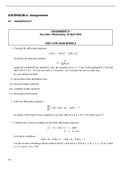Overig
APM3711 Numerical Methods II
- Vak
- Instelling
APM3711 Numerical Methods III is a third year UNISA module that focuses on problem solving and critical thinking. Its pre-requisite module is APM2613. Its purpose is to equip students with numerical techniques for the approximate solution of initial and boundary value problems of differential equat...
[Meer zien]




